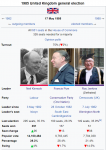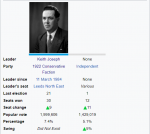

So how did we get here? Well for starters the Democratic Party is declared by Jenkins officially in 1983 as a merger between the SDP and the Liberals. The coalition between the Democrats and the Conservatives is not a pretty sight. After Thatcher resigns a brutal leadership battle between Edward Du Cann and Francis Pym results in a victory for Pym and the One Nation Tories. The 1922 faction is angry but not willing to go and campaign on their own yet. Things start to change as in the 1983 deputy leadership election Ian Gilmour defeated Ian Gow and Airey Neave much to the anger of the 1922 faction. Then the Democrats put a hold on the privatization started by Margaret Thatcher and ended aid to Iran after human rights abuses against homosexuals and women are revealed in 1984. But the final straw was when Jenkins attempted to close several coal pits. Arthur Scargill, the leader of NUM declared a strike that crippled the UK. Jenkins feared looking careless decided to try and negotiate with Scargill. Joseph and the 1922 faction were enraged by this and called it a capitulation to a radical socialist. Pym behind the scenes opposed the negotiations which caused infighting within the coalition. Jenkins tried to negotiate with Scargill but an increasing number of MPs from the conservatives refused to accept any deal with Scargill. This spooked Scargill and he stalled the negotiations until he felt like he could trust Jenkins to follow through with any deal he struck. Plus, Scargill knew he could get a better deal out of a Labor government. Kinnock criticized Jenkins for the failed negotiations and for bowing to the "radical right." Jenkins's popularity collapsed and a no-confidence vote was brought by leftist MP Michael Meacher. Pym refused to vote for the no-confidence vote as he knew it would cost the Conservatives the election. At this point, the 1922 faction was in a full-on revolt due to them perceiving Pym as a coward and extension of the Democrats rather than a conservative. Still, Pym couldn't stop the vote which came back 330-320 against Jenkins. Pym looked like a fool and the 1922 faction was by this point independent of Pym who led the One Nation faction. The split crippled the Conservatives in the election as both factions spent money on defending usually safe seats from each other's factions and split the vote in numerous swing seats. Labor on the other hand was fairly united, minus a split in Scotland by Jim Sillars and Alex Salmond of the Scottish Labor Party (SLP). But this was only two seats and with an unpopular Democratic Party and split Conservative Party Labor was able to dominate the election.
Their platform was more moderate than in 1982 and appealed to both socialist and moderate voters. Kinnock promised to compromise with NUM while not completely bowing down to them. Ordinarily, this would not be a winning position due to it being open to a ruthless counterattack by Conservatives as bowing to the pressure of a radical. In this case, though this was the best option to the public. The miners had voted to go on strike overwhelmingly and pragmatic politicians and miners compared their struggle to the Solidarity strikes in Poland. Scargill would reject his comparison, but it didn't matter. When the UK people saw the miners, they saw workers fighting for their way of life. The populace didn't appreciate the strike but felt like the miners deserved some respect and a compromise would do the trick. Both Pym and Jenkins promised further negotiations that would be "firm but fair" and the 1922 faction promised to wait out the strike. Come election day the result wasn't in doubt, only how large was the Labor majority was going to be is the question on everyone's mind. It turns out it was the largest landslide since 1935 with Labor winning 391 seats and Prime Minister Jenkins losing re-election. Soon after Jenkins resigned as leader of the Democrats due to falling to third place. The conservative factions finally woke up to the fact their civil war was helping no one and allowed a Labor supermajority. Pym resigned as leader and was replaced by the maverick John Gummer. Gummer promised to not run in the leadership election as he felt like he wasn't the one to unite and heal the Conservative Party. The leadership election was won in a landslide by Michael Heseltine, who ran as the compromise candidate and easily won over Ian Gow and Peter Walker. Heseltine had it all. He was young, moderate, and appealed to both factions as well as the electorate. While he never became Prime Minister, he would give Kinnock a run for his money in the 80s and 90s.
Another important side effect of the vote splitting was the various independent candidates who became MPs. Whether they were independent conservatives, independent Labor, or Scottish Labor Party (SLP) members, a dozen would enter parliament for the first and last time. The SLP though would find success with them staying in parliament until 1997 when Salmond lost re-election to the Labor candidate.
Kinnock now stood as one of the most powerful men in the world. During his tenure he would face unprecedented trials. The Il Grande Tradimento scandal that brought down the Cianci administration and the Miners Crisis were the most notable events of his first three years in office, but his handling of these events combined with his masterful campaign skills would allow him to stay in office until his defeat by Malcom Riftkind in 1998. His ideology of Kinnockism would continue to influence the Labor Party even as the party swung to the center during the 2000s and 2010s. The soft left ideology cemented him along with Prime Minister Giuliano Vassalli a lasting titian of social democracy in Europe and today he is fondly remembered as the man who was instrumental in both the Northern Ireland peace process and the Athens Accords which ended the Cold War.







